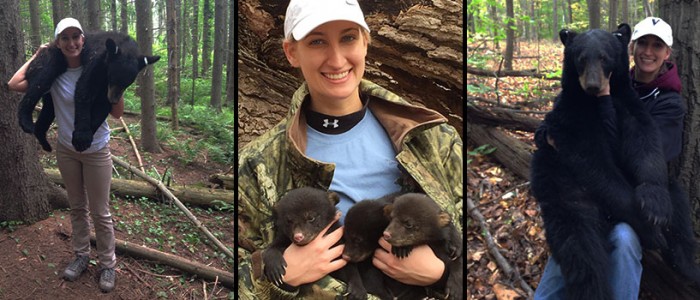Forensics Scientist Utilizes DNA Laboratory for Bear Attacks Across the Country

Posted by: admin on July 22, 2015, No Comments
In September 2014, New Jersey saw its first fatal bear attack since 1852. A 22-year-old student from Rutgers University was killed while he was hiking with five of his friends. The bear was killed at the scene and evidence material from the bear and victim was delivered to the Northeast Wildlife DNA Laboratory (NEWDL) at East Stroudsburg University of Pennsylvania. This was done to confirm that the bear euthanized was the bear that attacked the young student.
Nicole Chinnici M’14, forensics scientist at NEWDL, received the evidence, and began her examination to confirm that this was the bear that attacked the young man. On the claws, she was able to identify human blood. Further examination of the material submitted, and DNA evidence confirmed that the bear euthanized was the correct one.
This case initiated the development of a protocol for wildlife conservation officers and biologists to follow when dealing with wildlife attacks on humans. The protocol is designed to assist the biologists in collecting the best samples in the field that will yield quality DNA. It explains what the biologist should be looking for, how to collect the samples and how to ship the samples back to the laboratory.
She provided the state of New Jersey with that protocol and presented it at a conference in Mississippi in April 2015. A few months later, on a Sunday morning, Chinnici’s phone started ringing with news of another bear attack — this time in Tennessee’s Great Smoky National Park.
The bear attacked a 16-year-old boy, who was on a camping trip with his father. The father left with his injured son before biologists were able to retrieve DNA samples from the victim. The rangers left backpacks behind to lure the bear back to the campsite. A bear returned to the campsite and it was euthanized. Tissue samples from the bear and additional samples from the campsite were sent to the NEWDL. Ms. Chinnici was able to determine that the samples did not match.
Samples of a second bear from the area were also sent to the laboratory. Since the DNA from the second bear was not of good quality only a 70% match between the second bear and the evidence from the campsite was obtained. This was not conclusive but does not exclude the bear in this attack.
These are not the first examples of how ESU’s NEWDL has helped to unravel the intricacies of cases involving Wildlife DNA. ESU’s laboratory is one of only a small number of wildlife forensic labs in the United States. Graduate students and interns at the laboratory get to experience the investigative process.
Chinnici has been working in the forensic lab at ESU for about a year. She completed her master’s thesis in 2014 on genetics of bears in Pennsylvania, New York and New Jersey. NEWDL has partnerships with a number of states to assist on bear identification when attacks occur.
Jumping into her career immediately following graduation, Chinnici could not imagine doing anything else.
“I have the best job — it’s CSI: Wildlife,” she said.
Search
Recent Posts

Provost’s Colloquium Series Presents “A Visitor Sentiment Analysis of PA Wineries: A Big Data Approach and A Guided Wine Tasting”
April 16, 2024 - Read more



